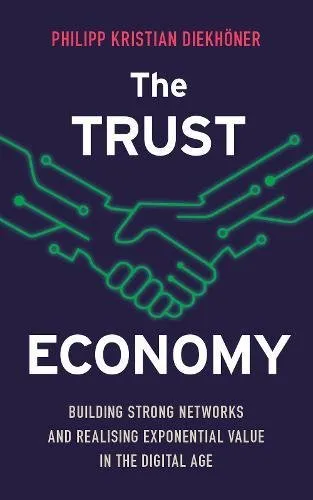Rise of the trust economy: 6 steps for startups to earn trust, create value, win customers
Interactive crowd-based platforms have helped accelerate the formation of trust networks. This book offers definitions and checklists for startups to form long-term customer relationships based on trust.

“A sizeable number of today’s largest, most impactful and highest-valued startups have something in common: they create new forms of trusted intermediaries,” says Philipp Kristian Diekhoner, a German entrepreneur and innovation consultant based in Singapore.
“Trust is a key enabler for economic value creation,” says Philipp. The more we trust in a product or service, the more value is created; the less we trust, the less value creation occurs. On the other hand, distrust or breach of trust destroys value and reduces competitive advantage.
Billion-dollar platforms have been built around the nucleus of trust. Philipp spells out six steps in creating trust for innovative companies in his debut book, The Trust Economy: Building Strong Networks and Realising Exponential Value in the Digital Age.
The 10 chapters are spread across 224 pages. Here are my key takeaways from the book; see also my reviews of the related books about the rise of peer platforms: The Inevitable (Kevin Kelly), Peers Inc (Robin Chase), and The Sharing Economy (Arun Sundararajan).
Startups, innovation, and trust
Giants like Google, Amazon, and Facebook as well as more recent players like AirBnB and Uber have leveraged the power of crowds through their platforms. Social capital via online communities have created a “relationship renaissance,” and re-introduced elements of the pre-industrial barter and trade economy – but on a massive, real time, global scale.
Interpersonal and collective trust are creating new forms of social proof, which are enabling the social contracts of digitally-enabled models like blockchain. Trust is also reflected by broader socio-technical trends, for example, there was consumer discomfort about online shopping in the early days of e-commerce, but many shoppers are now used to the digital medium and have found ways to trust it.
Innovation works only if we trust that the new offering is better than the current way of doing things and is worth the switch, explains Philipp. Venture capitalists invest in startups only if they trust the team and believe their vision can be executed.
Philipp defines trust as “value realised by means of economic or social interaction.” It has connotations of reliability, capability, reciprocity, security and confidence. Over time, companies have leveraged this consumer trust into powerful brands, but this can be disrupted by nimble startups who can create better value.
“A brand is a guarantee of value, and trust is the most important ingredient to it,” explains Philipp. He offers six steps for startups to design trust. In the digital economy, trust is a two-way street.
The first three steps are proactively executed by the startup: perception, temptation, and connection. The next three steps are executed by the customers but must be facilitated by the startup: validation, attachment and affiliation.

Perception
Startups must build the right perception for consumers, via reputation, sentiments and intuition. It helps if the offering is addressed at a customer pain-point, real need or habitual activity.
Messages should be simple, authentic and honest, and analogies and metaphors can help describe new offerings to customers. The origin story is a useful tool for differentiation, and can help build trust and empathy.
Notable examples include the Dollar Shave Club (compelling message), DriveNow (BMW car sharing via SIXT), and Amazon’s ‘reputation system’ (customers vouching for products).
Temptation
Having set the stage, the startup must now make a call to action. This can be via a discount voucher, free-return policy, free trial period, taste tests, or free research reports. Pay-per-use models also help.
Examples include the bank ComDirect, which gives customers a reward if they sign up for an account – and even if they close the account (a creative reflection of confidence in its value proposition).
Connection
Empathy helps build a good customer connection. The startup should trigger a customer action for engagement, but not through annoying, unsolicited or harassing messages. The engagement platform should be safe and meaningful.
There should be a blend of consistency and some variety or personalisation in the offering. Ethical practices should also be followed, eg not using tricky clauses in fine print. In real world pitches and networking, expert salespeople can make a connection in just minutes.
Examples include Ritz Carlton (each employee has an allowance of up to $2,000 to remedy a customer complaint), Slack (emojis as a way of expression), TripAdvisor (traveller reviews), and Acuity Insurance (fun and humour in the workplace).

Validation
Validation is about becoming comfortable about assumptions, and making it easy for customers to get information about you. “Trust building is a social contact,” says Philipp; it is both an art and a science.
Validation can include giving customers free samples so they can actually feel the product for themselves. Internally, Google builds trust among its innovation teams by an equitable idea sharing and validation platform.
Attachment
This stage builds customer loyalty through repeat and habitual engagement. Trust has gone beyond willingness to do a one-off trial. At this stage, customers will come irrespective of discount offers or freebies.
Partnerships can help strengthen such attachments, eg. alliances between corporates and startups. Co-opetition can also be explored, through industry-wide alliances.
Examples include Aesop (high-end cosmetics with sample dispensers in luxury resorts and hip restaurants), Uber (exact time and price displayed prior to the trip) and Nespresso (free samples for members in its global boutiques).
Affiliation
In this stage, customers trust the brand so much that they become its pro-active and selfless advocates. “Advocacy is a good sign of trust,” says Philipp. He draws on Robert Cialdini's principles of influence: reciprocity, scarcity, authority, consistency, liking, consensus and unity.
Some companies reward customer for referrals, others do not do so explicitly in their ads. It certainly helps if the company has a strong sense of purpose which customers can connect to and be inspired by, eg Unilever’s commitment to using renewable energy.
“Understand purpose as a trust accelerator,” Philipp advises. This calls for a long-term perspective and not just focus on short-term opportunities for profit. “Credible, genuine visionary leadership is essential to companies building trust through purpose,” he insists.

The future of trust
“Trust is no longer static, permanent or unconditional – it is dynamic, temporary and sustained by data,” says Philipp. He feels startup sectors such as fintech can benefit greatly by creating trust frameworks for the large unbanked communities in regions of the world like Asia.
Decentralised, peer models of trust can scale much faster and better online than traditional top-down hierarchical models. Even internally, startup teams can have better alignment with founders and trust in their vision, as compared with large firms.
Trust influences personal, professional and commercial networks. “The most successful companies focus on maximising value for their users, which in turn maximises profits,” observes Philipp.
The book opens the door to further research on social and behavioural aspects of digital ecosystems, and the dynamics of trust in hybrid online-offline, C2C, B2C, B2B and B2E settings (as well as government and civil society organisations).
The so-called Fourth Industrial Revolution also has elements of a trust revolution. “Technology is a trigger of progress, trust is the actual enabler,” Philipp signs off.








